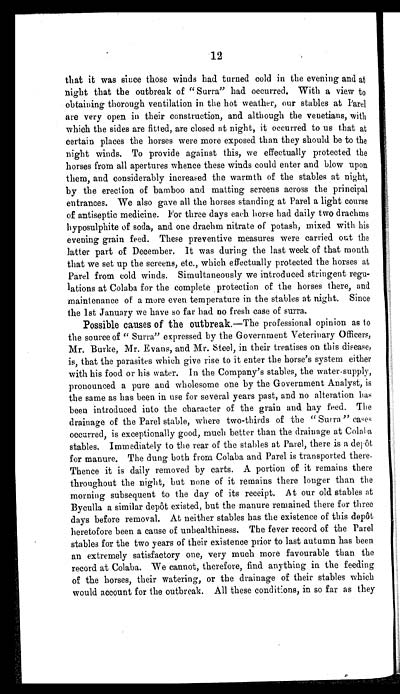Medicine - Veterinary > Civil Veterinary Departments > Civil Veterinary Department ledger series I-VI > Volume IV - Horse surra
(412) Page 12
Download files
Individual page:
Thumbnail gallery: Grid view | List view

12
that it was since those winds had turned cold in the evening and at
night that the outbreak of "Surra" had occurred. With a view to
obtaining thorough ventilation in the hot weather, our stables at Parel
are very open in their construction, and although the Venetians, with
which the sides are fitted, are closed at night, it occurred to us that at
certain places the horses were more exposed than they should be to the
night winds. To provide against this, we effectually protected the
horses from all apertures whence these winds could enter and blow upon
them, and considerably increased the warmth of the stables at night,
by the erection of bamboo and matting screens across the principal
entrances. We also gave all the horses standing at Parel a light course
of antiseptic medicine. For three days each horse had daily two drachms
hyposulphite of soda, and one drachm nitrate of potash, mixed with his
evening grain feed. These preventive measures were carried out the
latter part of December. It was during the last week of that month
that we set up the screens, etc., which effectually protected the horses at
Parel from cold winds. Simultaneously we introduced stringent regu-
lations at Colaba for the complete protection of the horses there, and
maintenance of a more even temperature in the stables at night. Since
the 1st January we have so far had no fresh case of surra.
Possible causes of the outbreak.—The professional opinion as to
the source of "Surra" expressed by the Government Veterinary Officers,
Mr. Burke, Mr. Evans, and Mr. Steel, in their treatises on this disease,
is, that the parasites which give rise to it enter the horse's system either
with his food or his water. In the Company's stables, the water-supply,
pronounced a pure and wholesome one by the Government Analyst, is
the same as has been in use for several years past, and no alteration has
been introduced into the character of the grain and hay feed. The
drainage of the Parel stable, where two-thirds of the "Surra" cases
occurred, is exceptionally good, much better than the drainage at Colaba
stables. Immediately to the rear of the stables at Parel, there is a depôt
for manure. The dung both from Colaba and Parel is transported there.
Thence it is daily removed by carts. A portion of it remains there
throughout the night, but none of it remains there longer than the
morning subsequent to the day of its receipt. At our old stables at
Byculla a similar depôt existed, but the manure remained there for three
days before removal. At neither stables has the existence of this depôt
heretofore been a cause of unhealthiness. The fever record of the Parel
stables for the two years of their existence prior to last autumn has been
an extremely satisfactory one, very much more favourable than the
record at Colaba. We cannot, therefore, find anything in the feeding
of the horses, their watering, or the drainage of their stables which
would account for the outbreak. All these conditions, in so far as they
Set display mode to: Large image | Zoom image | Transcription
Images and transcriptions on this page, including medium image downloads, may be used under the Creative Commons Attribution 4.0 International Licence unless otherwise stated. ![]()
| India Papers > Medicine - Veterinary > Civil Veterinary Departments > Civil Veterinary Department ledger series I-VI > Horse surra > (412) Page 12 |
|---|
| Permanent URL | https://digital.nls.uk/75517126 |
|---|




